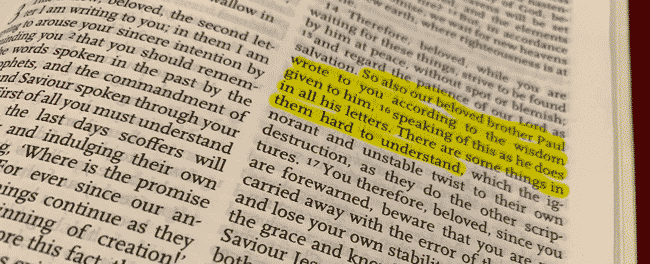Understanding what you read to others
It’s time to move on from looking at how the readings are fitted to the year, to some practicalities about how we approach the task of reading them aloud.
There’s a lot I can’t tell you about how to read in your church. I don’t know you or your context, whether you worship in a large or a small building, whether you have a sound system or a loop, which translation of the Scriptures your church normally uses, how many people you read to, and many other such things. The hints and tips in this section of the blog series are therefore necessarily going to be limited, but I hope they will be of some use, helping you become a more understanding and understandable reader.
The first and most important condition of reading well is to understand what it is you’re reading. That is what the largest part of this series, the “software” section to follow is all about. But how might you go about that if the reading seems particularly difficult, if you’ve read it through and are still wondering what it’s about? There are a number of things that you can do, which individually and together, can really help.
 |
I would first of all encourage you to go the main reference section of this series, and read both the introduction to that section of the Bible (Law, Prophets etc.) and the specific section on that scriptural book. It may even mention something specific about the passage you have to read. Other introductions are obviously available, and quite often they may be better and more expert than mine, but I don’t know of others that are shaped by the selections in the lectionary.
Next, look at it not in a missal or lectionary book of readings, or on the draft of the pew sheet you’ve been sent, but in a Bible. Look at what comes immediately before and after your reading, and see if that provides some context to help.
Another step you can take is only open to Anglicans and Protestants. Quite often the Revised Common Lectionary reading is longer than the one in the Lectionary for Mass. The latter very often fillets a passage down to a smaller number of selected verses, rather than reading straight through. Very often that means the Roman Catholic version1 follows a single line of thought or plot, leaving out any material the compilers thought extraneous. That selection may well help you grasp the main point, and come to an understanding of the passage.
The next step may depend on your resources. If you have more than one translation of the Bible in your house, look at the lection in a different translation2 and see if the way another group of translators has translated it helps. While I would very rarely encourage anyone to read from The Message3 in public worship (it’s too quick to rule out complexity in favour of one single clear meaning that will communicate well to modern Americans) it can be a really helpful version to consult on complicated paragraphs. The Good News Bible4 is another which is often worth consulting for clarity.
If you are still very uncertain what the passage is about having done this, then remember you can ask for help. The easiest thing to do is to ask your parish priest, deacon or licensed lay minister. This is one reason why it can help to look at the reading early in the week before you are due to read: it gives you time to ask for help. They will, I am sure, not only not mind that you ask them, but they will be positively pleased you care sufficently to want to understand well enough to help other people by reading with understanding. It may even alert them (if they are preaching) to a point they should cover in their homily.
Notes
- The readings for the current day’s mass are available online at Universalis . You can select days from the coming week from the sidebar on the right of the page. For a small fee, Universalis as also available as an app for both phone and computer.
- If you go online, one very useful site to bookmark is Bible Gateway. This site has a search bar at the top where you can enter the book, chapter and verses you wish to look up, and choose from many different translations which one you want to read. It offers an ecumenical and international range of translations, although its overall editorial stance is firmly evangelical.
- This is available in a number of editions, most recently, Eugene H. Petersen The Message Colorado Springs: NavPress, 2016.
- Many different editions of the Good News Bible are available from the Bible Society / HarperCollins publisher. Versions with the deuterocanonical books / apocrypha in are nowadays usually badged and sold as Catholic Editions.




Comments
Post a Comment